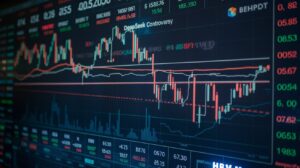The U.S. economy faces uncertainty amid trade tensions, challenging its long-standing reputation as an economic powerhouse. Ongoing tariff wars, shifting trade policies, and geopolitical instability are increasing economic volatility. This article will break down the key components of these uncertainties, explaining how they affect businesses, consumers, and global markets.
How Trade Tensions Are Impacting the U.S. Economy
Trade tensions refer to conflicts between nations over tariffs, trade barriers, and economic policies. The U.S. has been involved in several trade disputes, particularly with China, the European Union, and Mexico. These disputes lead to higher costs for businesses, inflationary pressure, and uncertainty in global markets.
Key Economic Challenges Due to Trade Tensions
| Economic Factor | Impact of Trade Tensions |
|---|---|
| Tariffs | Increased cost of imports and exports, leading to higher prices for businesses and consumers. |
| Dollar Depreciation | Reduced global confidence in the U.S. dollar, increasing inflation risks. |
| Supply Chain Disruptions | Industries like automotive and technology face production delays due to new trade restrictions. |
| Stock Market Volatility | Uncertain trade policies cause fluctuations in investor confidence. |
The Erosion of the Dollar’s Dominance
The U.S. dollar has historically been a global reserve currency, meaning it’s widely used for international trade and investment. However, trade tensions and aggressive tariff policies have led to a depreciation of the dollar, making imports more expensive and affecting investor confidence.
Consequences of a Weakening Dollar:
- Higher Inflation: A weaker dollar raises the cost of imported goods, leading to inflationary pressure.
- Foreign Investment Decline: Investors may shift to more stable currencies, affecting U.S. capital markets.
- Increased Cost of Borrowing: As confidence in the dollar weakens, borrowing rates may rise.
Impact on U.S. Manufacturing and Inflation
The U.S. government’s strategy to boost domestic manufacturing by imposing tariffs on foreign goods has mixed results. While some industries benefit from reduced foreign competition, others suffer from higher production costs due to increased material prices.
Inflation and Consumer Spending
Inflation remains a major concern. Higher prices for everyday goods reduce consumer purchasing power, leading to:
- Lower Retail Sales: Consumers cut back on spending due to rising costs.
- Higher Interest Rates: The Federal Reserve may increase rates to control inflation.
- Reduced Business Growth: Companies struggle with higher operating costs, slowing expansion.
The Global Trade Ripple Effect
The effects of U.S. trade policies extend beyond national borders, affecting global supply chains, international businesses, and economic growth worldwide. Countries that rely on trade with the U.S. must adjust their economic strategies to cope with these changes.
Global Reactions to U.S. Trade Policies
| Country/Region | Response to U.S. Tariffs |
| China | Imposed retaliatory tariffs on U.S. goods, impacting agriculture and technology sectors. |
| European Union | Strengthened trade partnerships with Asia and Latin America to reduce reliance on the U.S. market. |
| Mexico | Sought alternative export strategies and trade agreements with Canada and Europe. |
The Shift in Business Priorities
As trade tensions reshape the global economy, business leaders are shifting their focus. Instead of solely worrying about inflation and tariffs, many industries are investing in automation, artificial intelligence, and alternative supply chains to stay competitive.
How Companies Are Adapting:
- AI & Automation: Reducing reliance on labor-intensive manufacturing.
- Supply Chain Diversification: Moving production to regions less affected by U.S. tariffs.
- Digital Transformation: Increasing e-commerce and remote services to maintain revenue.
Conclusion: What Lies Ahead?
The U.S. economy is at a turning point, with trade tensions creating significant uncertainty. While protectionist policies aim to support domestic industries, they also introduce inflationary risks, market instability, and global trade disruptions. Policymakers and businesses must adapt to ensure long-term economic stability and growth.





